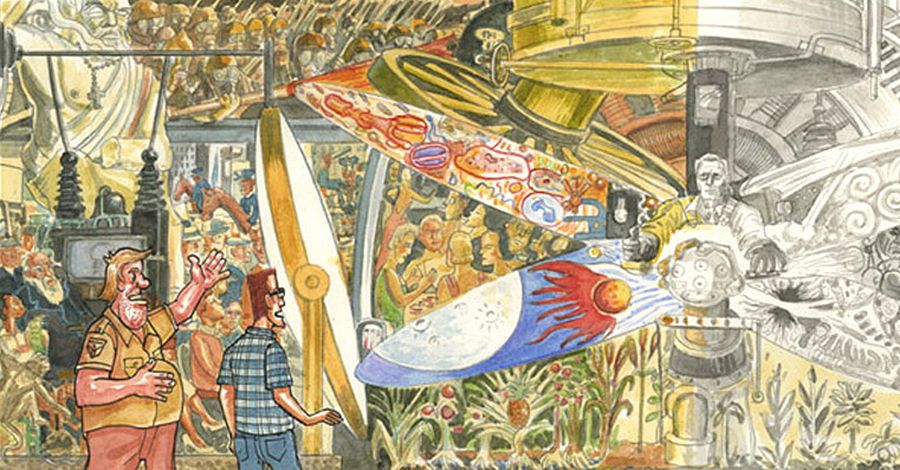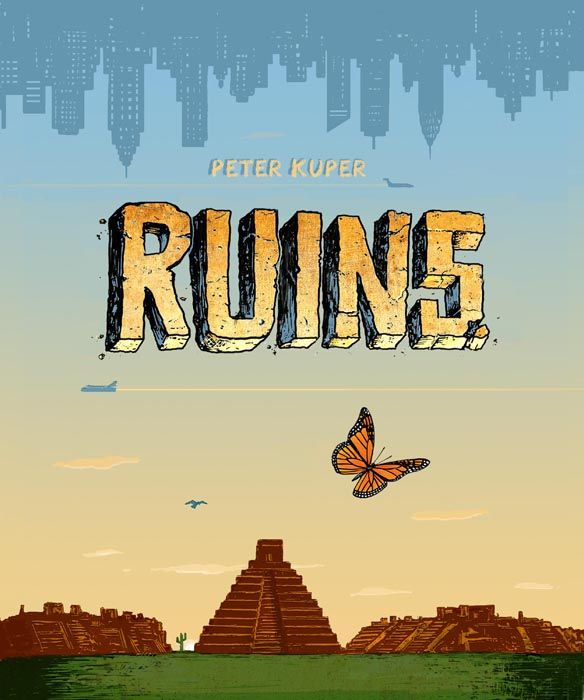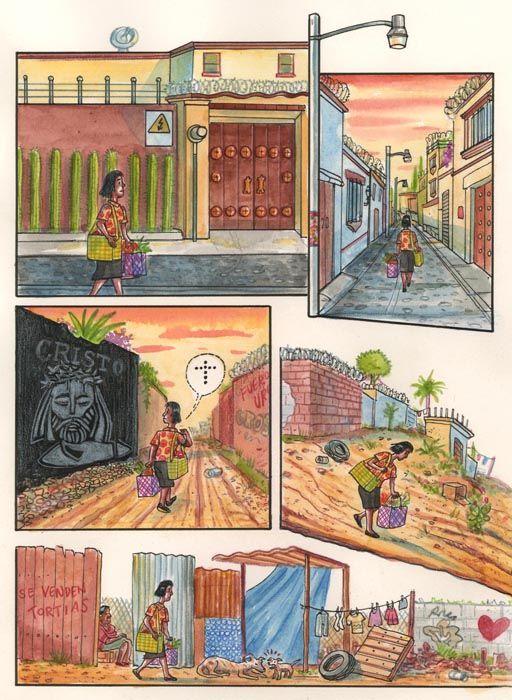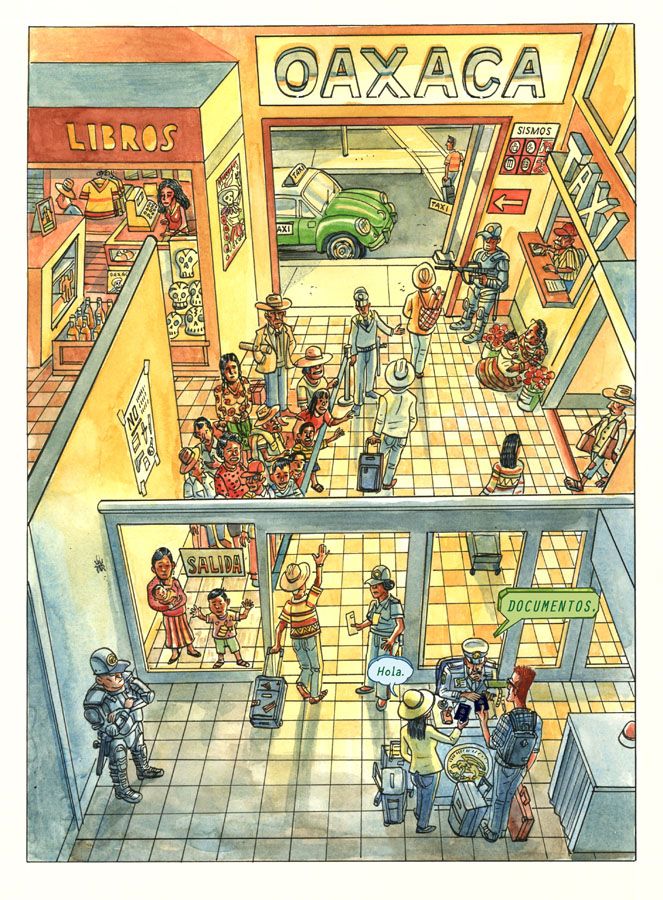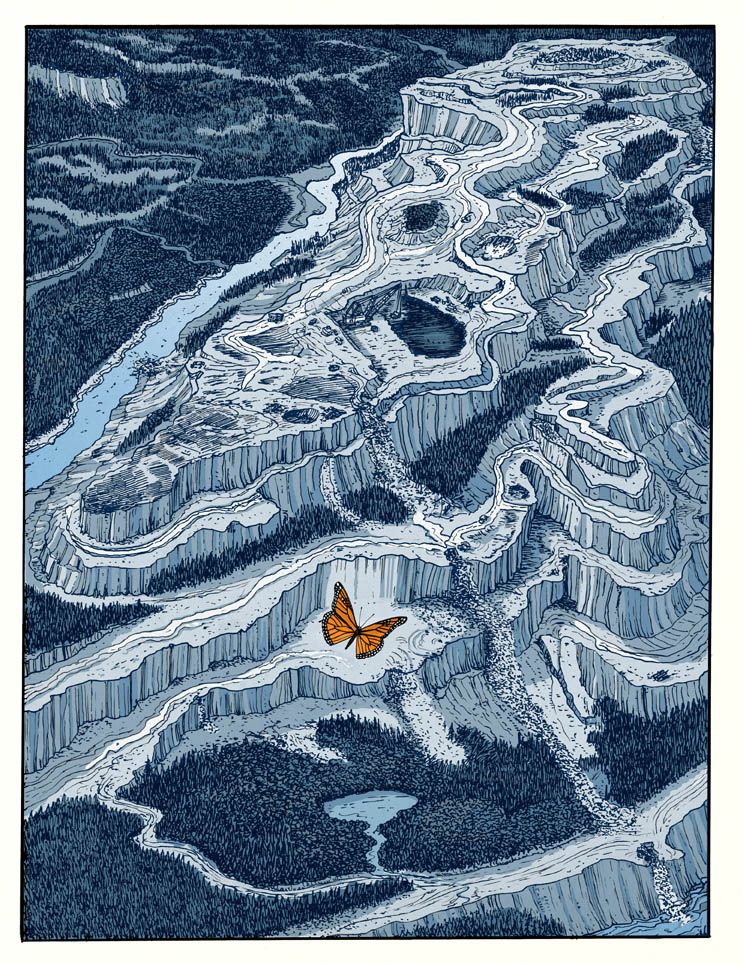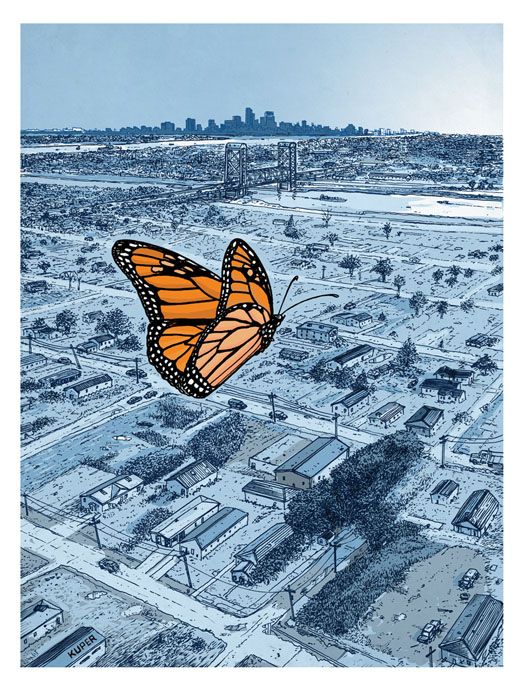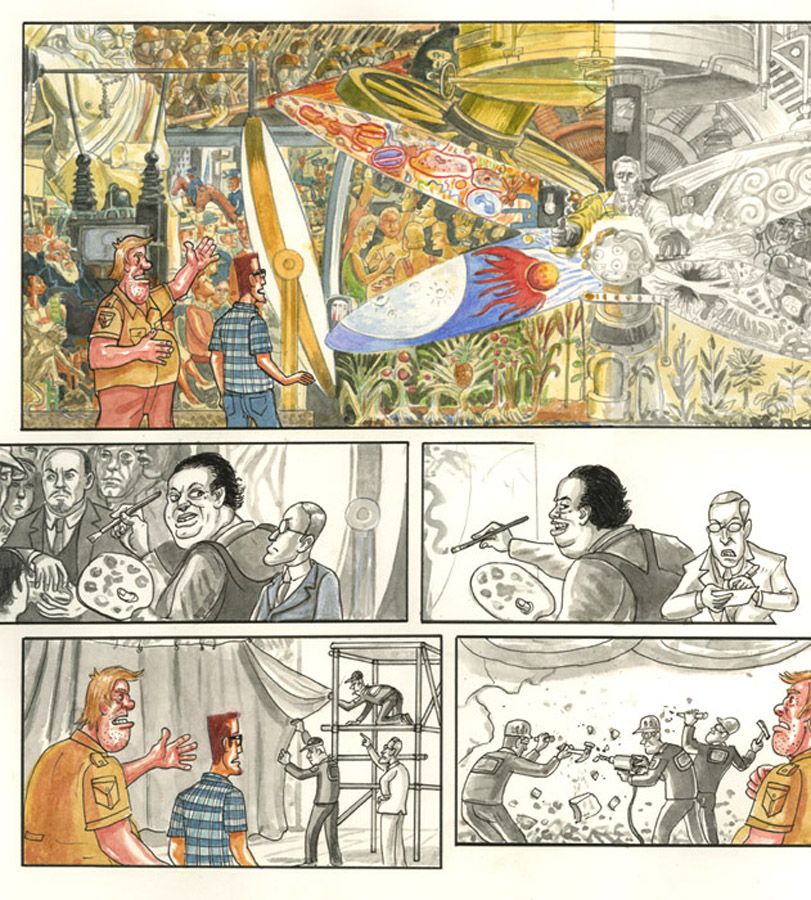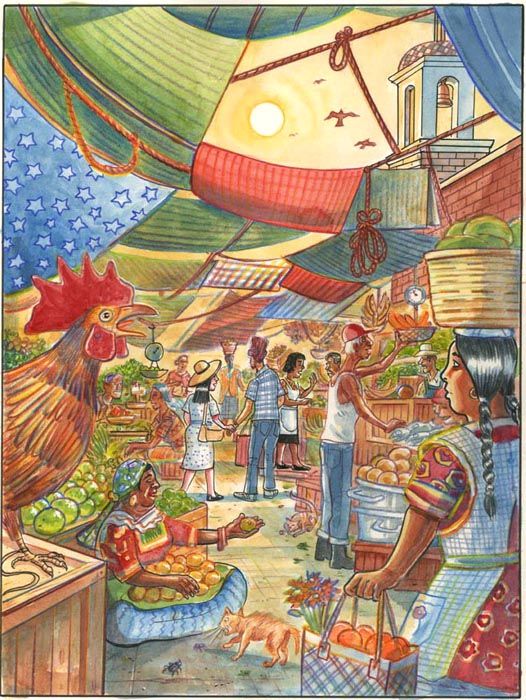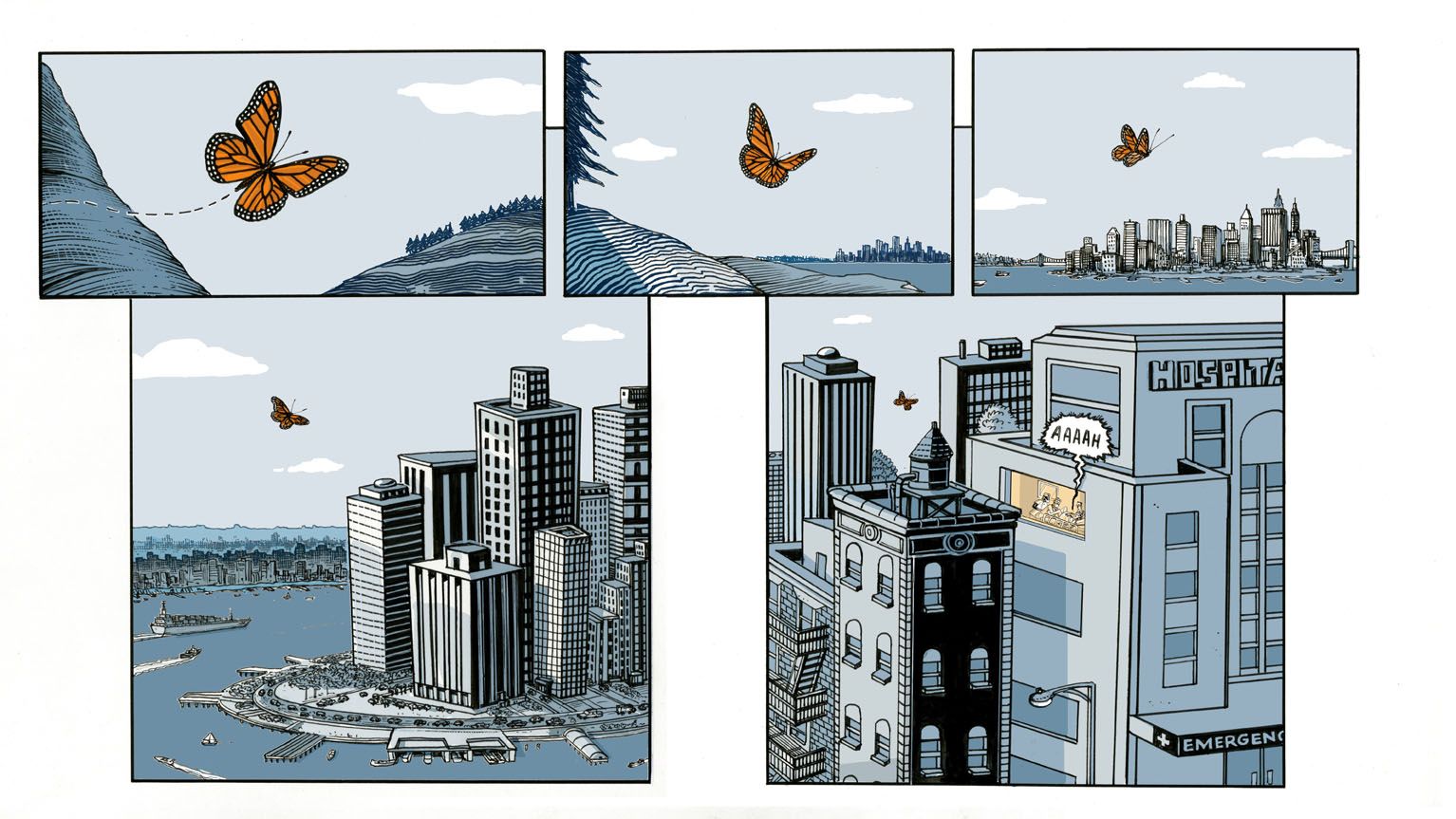Fans of cartoonist Peter Kuper have likely noticed the recurring importance of the Mexican city Oaxaca in his recent work. After living there for two years, Kuper documented his experiences with a sketchbook of drawings called "Diario de Oaxaca" that was published by PM Press in 2009, and he later revisited his time in Mexico in the pages of "World War 3 Illustrated," the leftist political comic book magazine that Kuper cofounded in 1979.
This September, Kuper, with publisher SelfMadeHero in tow, returns to Oaxaca with a new work of fiction titled "Ruins." Weaving together a variety of characters whose lives are thematically tied to the title, Kuper tracks the struggling relationship of Samantha, a teacher taking leave to work on her book, and the recently unemployed George. The duo travels from New York to Oaxaca and visits the ancient Mayan ruins where they see the violent teachers' strike of 2006. Similarly, a Monarch butterfly travels the route and witnesses the embattled situation of migrant workers and the worsening quality of the environment.
CBR News talked with Kuper about the themes of decay and rebirth in "Ruins," the lasting impact of Oaxaca on the cartoonist's work and the variety of projects that keeps him busy (hint: they involve teaching at an Ivy League university and drawing the continuing adventures of the most beloved cold war satire combatants of all time).
CBR News: "Ruins" has a few meanings in this book, like the remnants of ancient civilizations that surround Oaxaca and George and Samantha's foundering relationship. Also, the Monarch butterfly's route passes some troubling touchstones in the modern world and the teachers of Oaxaca face ruination. When did all these themes start to coalesce into a single book for you?
Peter Kuper: My first notes for this began in 2007 while I was still living in Oaxaca. We lived there for two years [2006-2008]. I didn't know exactly how the book would roll out -- I originally thought I'd make it autobiographical, but it moved into areas that suggested it would work better as fiction.
I wanted the characters right in the middle of events, including a teachers' strike that happened while we were down there, and as fiction I could do this. We had visited the Monarch sanctuary and I knew I also wanted that to be a big part of the story. I'm a closet entomologist and this was an opportunity to draw all kinds of insects. Given the state of the environment, I knew that would be an important aspect of the book too. To work on a project like this, I needed it to reflect a range of subjects that interest and concern me in order to have sustain throughout the time it would take to create.
Peter Kuper's "Diario de Oaxaca"
The idea percolated for a year or so and I realized it would be an enormous undertaking. I actually wasn't sure I had it in me, and since it was an oddball project -- and after the 2008 crash -- it was hard to find a publisher. It wasn't until 2011 that I finally could make the time to sit down and sketch it all out. I sent the rough form out to a number of publishers, but it didn't fit an obvious niche and for a while I had no takers. I decided to do it anyway and started drawing the first few pages. That same week, SelfMadeHero in England got back to me. I also found publishers in France and Mexico. Still, it took me three years to complete with nose to the drawing table for the last nine months.
Samantha's taken leave to focus on her book, but her desire to have a child seems to be the real driving motive here -- which is an awkward fit given her tension with George. Her book suggests that she's trying to fill a specific void in her life with a guy who isn't right for that role, doesn't it?
Without giving too much away, Samantha is reaching an age where having a child has begun to loom larger than perhaps it did before. Her writing a book is another form of giving birth, and that creation is also fraught. Working on it has stirred up her past, which ripples into her present. She is becoming aware that her biological clock is nearing midnight, so there's a new urgency. Like lots of couples, the question of having kids isn't necessarily all resolved when they get together. The visit to Mexico she hopes might nudge George in a new direction, including parenthood. She won't be the first person to have trouble getting what she needs from a relationship, but holds out the hope it can be made to work.
United States journalist Brad Will's death became a major international flashpoint in the 2006 Oaxacan teacher's strike, and one of your characters is a reflection of that tragedy. How did you balance the factual elements of the strike against the dramatic needs of your fiction? Did you feel beholden to certain truths?
The character of Al is based in part on a photojournalist named Tony Turok, whom I met and became friends with in Oaxaca. He was -- and is -- a brilliant photographer who went into a number of war zones and captured incredible images from places like El Salvador and Chiapas. Like Brad Will, he was downtown when the shooting started. I never crossed paths with Brad Will, though I discovered that many of my friends in New York had known him well. Brad had actually created a short piece for "World War 3 Illustrated" on an issue I hadn't edited, but I didn't put his name together with the printed piece until afterwards. I didn't want to feel beholden to the strictly factual events, which was one of the reasons I chose to make "Ruins" fiction. Nonetheless I based my story on many things that actually took place.
There's also a thread in the book about a Monarch butterfly traveling from New York to Oaxaca. Along the way, the butterfly witnesses some of life's harsher realities; does this story element also symbolize the emerging from darkness into a more beautiful, freer life -- which is something George, Samantha and the residents of Oaxaca are all grasping for?
The metaphors that presented themselves, between human struggles and those of the insect world, were almost too cliche to use -- though that didn't stop me! I hope I wasn't ham-fisted in presenting the contrast and comparisons between the Monarch and the various human circumstances I portrayed. It'll be up to the readers to decide. I felt like I was sticking to certain truths in showing the natural world in great distress given all the destruction to the habitats of humans and Monarchs alike. I also based many aspects on personal experience during my time in Oaxaca; trouble with scorpions and politicians abound there! Yet as doomy and gloomy as I tend to get, there are just too many examples of life persevering, or just plain beauty in the world, that I had to also present in order to paint a full portrait.
Your art style has evolved a lot over the years. In "Ruins," you work in monochrome and in color. What techniques and tools did you use?
Living in Mexico had a huge impact on my art. I spent tons of time drawing in my sketchbook, drawing from life there. When I returned to the States I had trouble picking up where I left off with iconic stencil and spray paint illustrations. I wanted to bring the palette and looseness I had in my sketchbook into my comics. I wanted to portray the visual experience I had going from a grey New York City to a very colorful Mexican setting and moving from monochrome to full color was one way to demonstrate this sensation.
I find in general I get restless if I work in one style or approach too long. I'm always experimenting in my sketchbook, sometime drawing more realistically sometimes cartoonier. Whatever serves the subject and my mood. I wanted the freedom to move between styles and tried to keep the parameters as wide as possible in "Ruins." Even in the design of the characters, I wanted to range from more realistic features to very rubbery and cartoony faces without sacrificing believability. Some backgrounds are very realistic while some are more impressionistic.
I worked in pen and ink, watercolor and colored pencils for the part of the story with characters in Oaxaca. For the alternating chapters following the migration of the Monarch butterfly, I used pen and ink; then I did the coloring in Photoshop. The Monarch sections are also wordless, which is kind of a breather from the chapters that are fairly text heavy.
Kuper & Tobocman Celebrate "World War 3 Illustrated"
I also played with the word balloons and color-coded the text so that when someone speaks Spanish the text is green, versus black for English. I liked the idea of conveying different languages without using the traditional << >> symbol. I also played with coloring the word balloons themselves and varying the shape of the word balloons to reflect each character's personality and tone of voice. Not that that is original to me, but it isn't used or considered very often in comics. It is especially handy when people are inside a building and you can identify who's talking based solely on their speech balloons.
Yet I hope all of this fancy footwork is just background for the reader and only makes the visual experience flow more smoothly and clearer.
This is your longest graphic novel to date, which is an accomplishment given everything on your calendar.
Yes, longest by a good stretch. I looked at my contract the other day and noticed it said I would deliver a 224-page book. It ended up being 328.
You're still teaching at SVA, correct? And now you've added a course at Harvard? How's that commute?
I really enjoy teaching and have continued at The School of Visual Arts in NYC now for about 25 years, though I've cut it back to one class and one semester. Harvard has been amazing and that makes the five-hour commute worthwhile. I love train travel anyway and it is a good time to catch up on reading and answering interview questions! I'm just starting my third year at Harvard and the students there are really a rewarding bunch each semester. It is really fulfilling to talk about approaches and make suggestions that are evident in the work the following week. I also get students from a wide range of disciplines -- economic majors, English and medieval studies majors, which makes for a greater diversity in the subjects they tackle. Also coming into contact with the other professors is brilliant.
And you still turn out "Spy vs. Spy" for "MAD", and your editorial work and contributions continue in "World War 3 Illustrated."
Yes on all counts. I co-edited and designed a huge hardcover collection of "World War 3" covering that 35 year history that PM Press published last year -- available at finer left-wing book stores everywhere and, of course, through the Amazon conglomerate beast. "WW3" is also still coming out as an annual magazine we self-publish and distribute through Top Shelf. I edited the last issue of the magazine with Scott Cunningham and the next one edited by a different set of editors should be out by the time you read this.
It doesn't seem like you have time for anything else, but what else is on your drawing table these days.
I do periodic illustrations; one recent one was for an "art inspired by 'Mad Max'" book that Vertigo published and various shorter comics for books like "Masterful Marks" -- I did Harvey Kurtzman's bio and will do another famous cartoonist bio for the next book -- and I adapted a WWI poem for a collection, "Above the Dreamless Dead." I'm art directing a weekly political illustration page for the French paper "Liberation" and am doing a full-page comic for "Le Monde," another French paper.
Over several years l worked on animation for a documentary called "Containment" about the impossible task of storing nuclear waste for the next 10,000 plus years. It was done by two Harvard professors, Robb Moss and Peter Galison, and should be available shortly. I had the fun job of animating -- not CGI or full animation, just enough images to give the art movement -- a series of sci-fi scenarios that a group of futurists, hired by the U.S. government, came up with. They tried to imagine how the waste disposal site in New Mexico might be breached and what ways present humans could warn future human not to dig the toxic waste up. I got to draw robots and spaceships and futuristic (for me, that all looks like the 1950's vision) drilling machines and trains.
So it was a real joy until I thought about the fact that in virtually all the scenarios we dig, and we die. Somehow my work just keeps illustrating our troubles, but I'm smiling where I can.
"Ruins" will be released on September 22.

